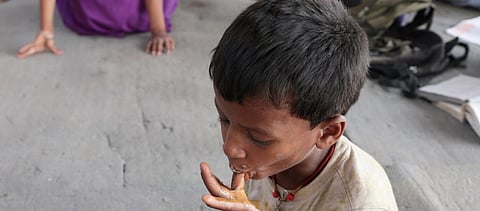

Small food shocks can increase the burden of malnutrition in India where almost half the children falling under at least one category of malnutrition, according to a recent study.
The nationwide lockdown to curb the spread of the novel coronavirus disease (COVID-19) pandemic can contribute to such food shocks and, in turn, increase the chances of malnutrition, said the study published in journal Global Health Science July 16, 2020.
The study is based on possible weight loss due to the immediate food shock children may face because of the pandemic.
Food shocks may lead to reduction of body weight of many children. Among them, there are many who may fall in the criteria of wasting or under-weight set by the World Health Organization (WHO).
The study attempted to estimate children who can suffer from a small food shock and fall to the threshold of the malnourished category. It also provided estimates in several scenarios from bodyweight shock of 0.5-5 per cent.
In a scenario of five per cent weight-loss, India will experience an increase of about 4,393,178 and 5,140,396 additional cases of under-weight and severe wasting respectively.
The estimates are substantially high for severe under-weight and wasting as well, said the study.
In first case of bodyweight shock of 0.5 per cent, 410,413 and 392,886 additional children can become under-weight and wasted respectively.
The number of severe under-weight and wasted children is expected to increase by 268,767 and 166,342 respectively, according to the study’s estimates.
Five million children are at risk of falling in the wasting category of malnourishment, while an additional two million children are at risk of being pushed into the severe wasting category, the study pointed out.
Wasting refers to a low weight-for-height ratio, indicating recent and severe weight loss. This can occur due to not having enough to eat and / or suffering from an infectious disease that causes such weight loss.
Being under-weight, on the other hand, is defined as having a low weight-for-age ratio. A child who is under-weight can be stunted, wasted or both.
“Nutritional status of children is sensitive to the smallest of the shocks to bodyweight,” said the study. “In fact, a reduction of 0.5 and 1 per cent in weight can lead to substantial increase in under-weight and wasting prevalence in the country,” the study added.
Bihar, Madhya Pradesh and Uttar Pradesh will be the most affected and account for the highest share in estimated additional under-weight and wasting cases among the poorest households, said the study.
The present classification of malnutrition is based on formulae given by the WHO. The Union government periodically conducts a nationwide survey known as the National Family Health Survey (NFHS), which covers malnutrition.
Every second child in India suffers from at least one form of nutrition failure. It might be stunting, under-weight, or wasting, according to the survey conducted in 2015-16. These figures translate to about 77 million under-nourished children in India.
The survey, however, does not give information on children clustered around the threshold and are at an elevated risk of under-nutrition through minor shocks to their bodyweights. The study attempted to solve this problem.
Almost every issue faced by the country has been overlooked because of the COVID-19 pandemic. This includes malnutrition, a problem that former prime minister Manmohan Singh called a “national shame”.
The efforts of all the healthcare workers and anganwadi workers have been diverted in dealing with COVID-19, with malnutrition not being paid the attention that it needs, according to ground reports.
The study — carried out by Sunil Rajpal, SV Subramanian and William Joe — is titled Living on the edge? Sensitivity of child under-nutrition prevalence to bodyweight shocks in the context of the 2020 national lockdown strategy in India.
Sunil Rajpal is associated with Institute of Health Management Research, Indian Institute of Health Management Research (IIHMR) University, Jaipur.
SV Subramanian is associated with Department of Social and Behavioral Sciences, Harvard TH Chan School of Public Health, Boston, United States and William Joe is from Population Research Centre, Institute of Economic Growth, Delhi.